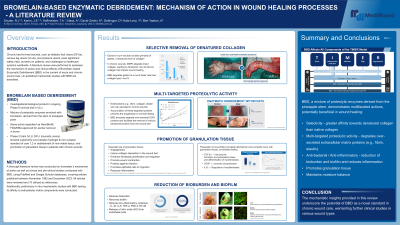Clinical Research
(CR-079) Bromelain-based Enzymatic Debridement: Mechanism of Action in Wound Healing Processes, a Literature Review
Friday, May 2, 2025
7:45 PM - 8:45 PM East Coast USA Time

Ead Karim, DPM, MS; Timothy A. Hoffmeister, BS; Anwar Nass, MBS, BS; Keren David-Zarbiv, MSc,BS; Yael Katz-Levy, PhD; Dafna Geblinger, PhD; Aya Ben Yaakov, PhD, MSc, BS
Introduction: Chronic hard-to-heal wounds, such as diabetic foot ulcers (DFUs), venous leg ulcers (VLUs), and pressure ulcers, pose significant safety risks, burdens on patients, and challenges to healthcare systems worldwide. A literature review was performed to assess the mechanism of action and clinical effects of Bromelain-based Enzymatic Debridement (BBD) in the context of acute and chronic wound care. Unpublished mechanistic studies with BBD are further described.
Methods: A thorough literature review was conducted on bromelain’s mechanism of action as well as clinical and preclinical studies conducted with BBD, using PubMed and Google Scholar databases, covering articles published between November 1992 and December 2023. Additionally, preliminary in vitro mechanistic studies with BBD testing its affinity to extracellular matrix components were conducted.
Results: Ninety-four articles were reviewed, and 70 utilized as references. This review shows that bromelain, a mixture of proteolytic enzymes derived from the pineapple stem, exhibits multifaceted actions that may be beneficial to wound healing, including multi-targeted proteolytic activity, anti-inflammatory effects through the reduction of pro-inflammatory cytokines (e.g., IL-1β, IL-6, TNF-α, PGE-2, NF-κB), and the release of nitric oxide from endothelial cells. In vitro mechanistic studies demonstrated that BBD degrades denatured collagen (i.e., gelatin) twice as fast as native collagen. BBD showed higher collagenase activity and stronger affinity toward collagen types I and III compared to types II and IV. Additionally, BBD proteases effectively degrade various ECM proteins, including elastin and fibrin. Clinical trials reveal that BBD expedites wound debridement in thermal burns, VLUs, and DFUs, promotes granulation tissue formation, disrupts biofilm, and reduces bioburden.
Discussion: The combination of literature review findings and available nonclinical and clinical data highlights BBD’s potential as an innovative standard for chronic wound care. Its unique enzymatic composition enables rapid and effective debridement of diverse non-viable tissues in chronic wounds. Further clinical validation across various wound types is warranted to fully establish BBD’s mechanism of action and utility.
Methods: A thorough literature review was conducted on bromelain’s mechanism of action as well as clinical and preclinical studies conducted with BBD, using PubMed and Google Scholar databases, covering articles published between November 1992 and December 2023. Additionally, preliminary in vitro mechanistic studies with BBD testing its affinity to extracellular matrix components were conducted.
Results: Ninety-four articles were reviewed, and 70 utilized as references. This review shows that bromelain, a mixture of proteolytic enzymes derived from the pineapple stem, exhibits multifaceted actions that may be beneficial to wound healing, including multi-targeted proteolytic activity, anti-inflammatory effects through the reduction of pro-inflammatory cytokines (e.g., IL-1β, IL-6, TNF-α, PGE-2, NF-κB), and the release of nitric oxide from endothelial cells. In vitro mechanistic studies demonstrated that BBD degrades denatured collagen (i.e., gelatin) twice as fast as native collagen. BBD showed higher collagenase activity and stronger affinity toward collagen types I and III compared to types II and IV. Additionally, BBD proteases effectively degrade various ECM proteins, including elastin and fibrin. Clinical trials reveal that BBD expedites wound debridement in thermal burns, VLUs, and DFUs, promotes granulation tissue formation, disrupts biofilm, and reduces bioburden.
Discussion: The combination of literature review findings and available nonclinical and clinical data highlights BBD’s potential as an innovative standard for chronic wound care. Its unique enzymatic composition enables rapid and effective debridement of diverse non-viable tissues in chronic wounds. Further clinical validation across various wound types is warranted to fully establish BBD’s mechanism of action and utility.

.jpg)